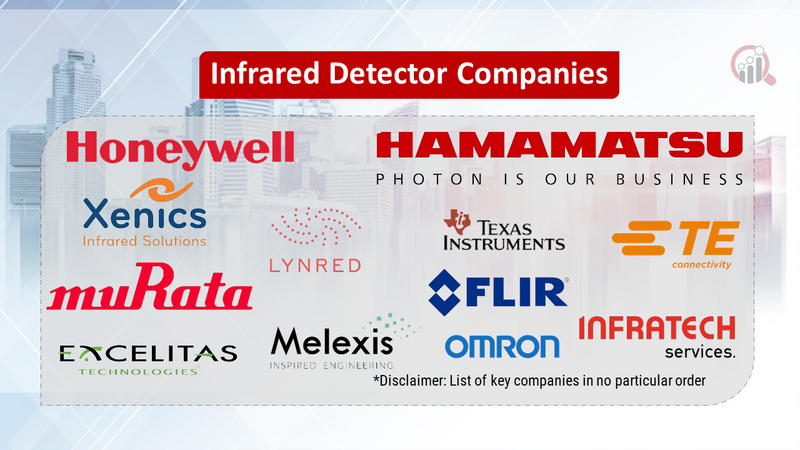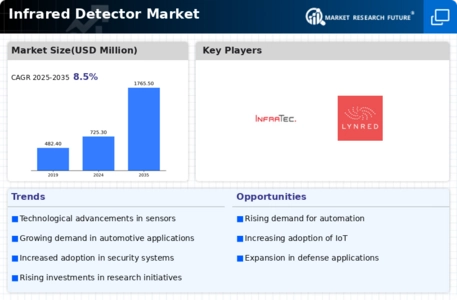Top Industry Leaders in the Infrared Detector Market

Seeing Through the Heat: Decoding the Competitive Landscape of the Infrared Detector Market
The ability to perceive warmth has always captivated humanity, and with advancements in technology, we've transcended mere sensation to capture and analyze heat signatures with infrared detectors with established players and innovative startups vying for dominance. Let's navigate the infrared spectrum, analyzing key players, their strategies, and the factors impacting market share.
Key Players:
- Excelitas Technologies (US)
- FLIR Systems, Inc. (US)
- Hamamatsu Photonics (Japan)
- Murata Manufacturing (Japan)
- Texas Instruments (US)
- EXCELITAS Technologies (US)
- Hamamatsu Photonics (Japan)
- Murata Manufacturing (Japan)
- FLIR Systems Inc.(US)
- Texas Instruments (US)
- Nippon Ceramic (Japan)
- Omron Corporation (Japan)
- INFRATEC (Germany)
- LYNRED(France)
- TE Connectivity (Switzerland)
- Honeywell International (US)
- Raytheon Company (US)
- Laser Components (Germany)
- Dräger (Germany)
- Vigo System (Poland)
- XENICS (Belgium)
- MELEXIS (Belgium)
- Fagus GRECON (Germany)
- Thorlabs (US)
- SEMITEC Corporation (Japan)
Factors Dictating Market Share: Seeing Beyond the Obvious
-
Detector Technology and Performance: The range of wavelengths detected, sensitivity, resolution, and operating temperature significantly impact market share. Players with advanced detector technologies (like long-wave infrared or high-resolution microbolometers) hold a competitive edge.
-
Application Focus: Catering to diverse segments like thermal imaging for defense, night vision for consumer applications, or process control in industries opens doors to wider customer bases. Players with broad application range and tailored solutions gain market traction.
-
System Integration and Packaging: Offering complete infrared camera systems or modules that seamlessly integrate with existing equipment attracts customers seeking turnkey solutions. Players with strong system integration capabilities thrive in such markets.
-
Cost and Pricing Strategies: Balancing advanced technology with cost-effectiveness is crucial. Offering tiered solutions or subscription models based on features and applications caters to diverse budgets and expands market reach.
Emerging Stars in the Infrared Spectrum:
Several new entrants are disrupting the market with innovative solutions and disruptive pricing models. These companies often focus on specific technologies or address unmet needs in niche segments. Some notable examples include:
-
Blackbody Inc.: Develops uncooled microbolometer arrays with exceptional sensitivity and resolution, targeting high-performance industrial and scientific applications.
-
IRnova: Offers miniaturized, low-power infrared cameras for integration into drones and wearable devices, expanding the possibilities of consumer and commercial applications.
-
QMC Instruments: Designs advanced quantum cascade lasers for hyperspectral imaging, enabling precise molecular identification and gas detection in environmental and medical fields.
Investment Trends Fueling the Competitive Fire:
Companies are actively investing in various areas to secure their positions in the competitive landscape:
-
Next-generation Detector Materials: Research on novel materials like gallium nitride and graphene for higher sensitivity and wider wavelength detection is a major focus area.
-
Microbolometer Miniaturization and Array Development: Advancements in microbolometer technology, leading to smaller, higher-resolution arrays, are driving significant investments.
-
Integration with AI and Machine Learning: Algorithms for image processing, target recognition, and anomaly detection are being embedded into infrared systems, enhancing functionality and value.
-
Expansion into Emerging Markets: Targeting regions with growing security, industrial, and environmental concerns like Asia and Latin America is driving regional expansion efforts.
Latest Company Updates:
- January 9, 2024: The US Department of Defense announces plans to invest in next-generation infrared detector technologies for improved battlefield awareness and soldier protection.
- December 19, 2023: A study published in Nature Materials describes a new type of infrared detector made from a single layer of atoms, potentially revolutionizing the field with its unmatched sensitivity and compactness.
- December 5, 2023: Teledyne FLIR acquires California-based start-up, Geobi, strengthening its position in the high-end infrared camera market for defense and aerospace applications.










